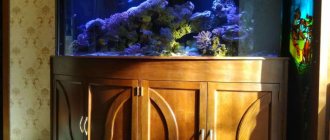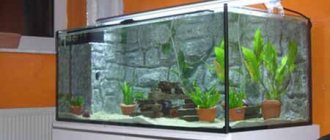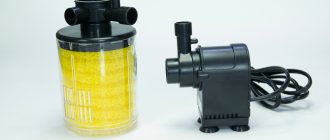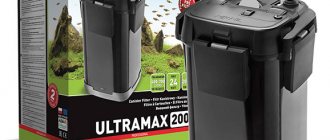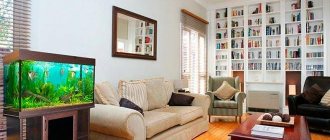Disabling the filter or pump
Let's start by disabling filters. Typically, the issue of disabling concerns only internal filters. Many people lose sight of the fact that it is not the filter itself that makes noise, but the hose that draws in air.
It turns out that the filter can be left on in any case and only the air supply hose can be disconnected. This can be done if the fish have enough air from the surface dissolved in the water.
Usually, if there are not many fish and the fish are small, and the displacement of the aquarium is large, then air supply is not necessary. But still, I recommend checking it out. To do this, turn off the air supply during the day and watch the fish for 2-4 hours. If the inhabitants of the aquarium float to the surface, then there is not enough air in the aquarium and it cannot be turned off. If the fish behave as if nothing had happened, then the air can be safely turned off.
The same rules apply to the butt. Pump noise is usually related to the air supply. If the pump makes noise on its own, then it is better to check its serviceability.
And I’ll tell you this life hack. If the air supply cannot be turned off, then a piece of cotton wool or synthetic padding can be loosely applied to the place where the air is sucked into the hose.
Aquarium filters: WHY they are needed, HOW they work and WHY they cannot be turned off
This note is intended for beginner aquarists. The reason for writing it was one very popular question that we have to listen to, if not every day, then weekly: How long should an aquarium filter work, all day? And is it possible to turn it off at night? Indeed, newbie aquarists often operate the filter intermittently, turning it on and off. This is where their usual and very serious mistake lies: the aquarium filter must work continuously! Turning it off is both pointless and harmful. Why is that? To answer this question, let’s first look at the filter design. By the word filter we mean a device consisting of two parts: a turbine head (a pump that pumps water) and a cartridge with filter material. There are internal filters (those that are immersed directly into the aquarium), and there are external ones, sometimes called “buckets” by experienced aquarists. This “bucket” stands near the aquarium and is connected to it with hoses. The volume of filter material in external filters is much larger than in submersible (internal) filters and it is placed there in such a way as to work with maximum efficiency. So the use of external filters is incomparably greater than that of internal ones. But the principle of operation of both is the same: they pump water through the filter material.
So, WHY do you still need aquarium filters?
A filter in an aquarium is needed for mechanical purification of water from turbidity, for chemical purification of water from waste products of fish and other aquarium inhabitants, and also for mixing the water. For a small filter, where there is almost no filter material, this last function may even be the most important. A fairly strong stream of water from the filter head creates a current in the aquarium. A properly installed filter constantly mixes the upper and lower layers of water, facilitating gas exchange between the aquarium water and the air in the room where it is located. The layer of water in contact with the surface releases the accumulated carbon dioxide, becomes enriched with oxygen and goes deeper. There are no stuffy stagnant zones left in the aquarium and the fish do not constantly stand at the surface, but are distributed throughout the entire volume, because the concentration of dissolved gases becomes approximately the same everywhere. Many filters have an outlet tube, from which a stream of water flows, that has a special fitting onto which an air intake tube can be attached. In this case, the stream of water carries with it many small air bubbles, providing very effective aeration. And here many beginners who buy an aquarium with a tightly closing lid make an important mistake: they leave the outer end of the air intake tube underneath it. As a result, the stream of water is enriched with the same air, which has already lost a significant amount of oxygen and has managed to become saturated with carbon dioxide. If there are no living plants in the aquarium - an additional source of oxygen, everything often ends in the death of the fish. In aquariums with a blind lid, the air intake tube of the filter must be led outside, then a constant supply of fresh air will be ensured. See how to do it:
| Video 1. Correct installation of the internal filter in the aquarium. Details here. |
How do aquarium filters work?
But let's return to the main topic - filtering. HOW
is it happening?
It would seem, well, what questions could there be? The filter material traps dirt. When it becomes clogged, you will need to rinse it thoroughly with lukewarm water to make it cleaner and put it on again. If you do this often and carefully, the water in the aquarium will always be clear! But it was not there! When the filter is used in this way, the nasty white cloud will relentlessly haunt the aquarist and develop more rapidly the more often the diligent beginner washes the filter. It turns out that cleaning aquarium water includes two processes: mechanical and biological. Dirt particles are retained on the filter material - this is mechanical filtration. But then saprophyte bacteria take over this dirt and decompose it into simple mineral substances. Ideally, before water, carbon dioxide, nitrates, phosphates and some others. This is biological filtration. And if it is carried out in full, the water in the aquarium will be crystal clear. But this is ideal, that is, if the filter substrate is densely populated with bacteria. In fact, the filter media is the location of a giant colony of microorganisms. But in the new filter this colony has not yet formed. And if you wash the filter thoroughly every time, then it will not form. In this case, biological filtration of aquarium water will not be carried out to its full extent. The aquarium water will be saturated with semi-decomposed organic substances, and microorganisms will breed in huge quantities right in it, making it whitish-turbid! The aquarium filter practically does not retain bacteria and it is useless to hope to filter them out. What should we do then? You don’t have to do anything - it will go away on its own with time. The “correct” bacteria will settle in the filter; when there are a lot of them, they will prevent the release of half-decomposed organic matter into the water and the bacteria freely floating in the water will die of hunger - the white turbidity will disappear. The water will become clear and biological balance will be established in the aquarium. The filter media should only be washed when necessary. Those. when its overgrowing with bacterial films and silt begins to interfere with water pumping. In this case, it is strictly forbidden to use any detergents. It is best to rinse it with water downloaded from the same aquarium during a partial replacement. The purpose of this procedure is not to wash the filter until it is sterile, but to free the pores of the filler and restore a sufficiently free flow of water through the filter. The process of establishing biological balance (in other words, starting the aquarium) can be accelerated many times if you put an old, slightly silted filter from a healthy aquarium into the new aquarium, or add a sufficient amount (about 10-15%) of old soil.
You can also rinse the sponge of the working filter from an aquarium with established biological equilibrium in a small amount of aquarium water and safely pour the resulting dark liquid into a new aquarium. In addition, there are special bacterial preparations that also significantly speed up the process of starting an aquarium. And in conclusion we will answer the question:
WHY CAN'T YOU TURN OFF THE AQUARIUM FILTER?
Yes, because in fact it is alive, and without an influx of fresh water saturated with oxygen, it will quickly die. Instead of beneficial nitrifying bacteria, anaerobic microorganisms will settle in it, which will begin to release hydrogen sulfide and methane. If you start it without washing a switched off filter that has been standing for several days, the fish may be poisoned. Let us tell you a real case from our practice. One day in a pet store, our attention was attracted by a young man who was trying to return a filter he had purchased not so long ago. The argument boiled down to the following. “As long as the filter is not working, the fish live, although they suffocate slightly, but if you turn on the filter, they die!” It turned out the following. The filter worked all week and everything was fine. Before leaving for the weekend to the country, the filter, along with other electrical appliances, was turned off. After the owners arrived home, the fish were alive, but they turned on the filter and soon they began to die. Therefore, the unlucky aquarist came to the conclusion: the filter cannot be turned on, it is harmful, it kills the fish. YES, IT REALLY BECAME HARMFUL BY STANDING OFF FOR TWO DAYS .
How to increase the biological power of the filter is described and shown in our next article about the filtration of aquarium water: “Why do small filters fail to purify aquarium water? Size matters!". Don't know how often you should wash your aquarium filter? This is discussed in a special article.
Author:
Vladimir and Elena Kovalev
Author:
material updated 08/26/2014
Compressor shutdown
The compressor is a slightly different story. The compressor is only responsible for supplying air to the aquarium and makes noise on its own. You can turn off the compressor only if the fish have enough air without it. You can check it the same way as with air supply from the internal filter: leave the fish for several hours without air and see in which layer of water they stay. If it is low or medium, then everything is ok and the compressor can be turned off at night. If everyone is swimming under the surface, then you need to immediately turn on the air supply again and do not turn it off at night.
In this case, the only way out is to hide the compressor in another place or place it in a thick box. This should reduce the noise, but you need to make sure that the compressor does not overheat.
Does noise bother fish?
It is impossible to find out exactly how the fish in the aquarium react to the fact that the compressor is noisy.
No research has yet been conducted on this issue. But it is known for certain that the lack of aeration is absolutely harmful for them. Even if the aerator is a little noisy, the most important thing is that it is there and constantly working. Many aquarists believe that if the noise is uniform, then the fish get used to it and stop noticing it. The validity of this assumption can be verified by observing the inhabitants of the aquarium while the aerator is operating. They will calmly go about their business. But if you try to knock on the walls, the fish will immediately notice it.
Thus, even if the noise of the aerator is an irritant for the fish, they quickly get used to it and stop reacting. Unexpected noise can cause the fish to get scared and sometimes even jump out of the aquarium.
The noise of a compressor often disturbs a person. If you experience such inconveniences, then try to soundproof the motor, but do not turn off the aerator at night under any circumstances.
Experienced aquarists note that domestic compressors are usually noisier than high-quality foreign ones. An additional advantage of the latter is a long hose, which allows you to “hide” the compressor further away, where it will not make noise or disturb you or the fish.
Some tips for reducing noise
In order to enjoy a healthy sleep, it is necessary that the noise from the aquarium be as little as possible. Therefore, I give some tips.
- Try not to place an aquarium in the bedroom unless you have figured out how to ensure silence in advance.
- Don't put in too many fish. There should be enough residents so that they can do without air supply.
- Choose silent aquarium equipment if silence is important to you
- If you decide to turn off the air at night, do not feed the fish beforehand. After eating, fish consume more oxygen and, perhaps, in this case there will not be enough air.
- Add live plants to your aquarium. They absorb carbon dioxide and release oxygen.
That's all. Silence to you! =)
Which filter is better?
Perhaps no aquarist can give a definite answer to this question. There are quite a lot of models on the market that have been successfully used for a long period.
Sera
If we consider the problem from the point of view of the price for the device, then among the economy-class internal purifiers we can highlight the products of the German company Sera.
Inexpensive devices of this brand L30, L60, L120, L150 and even L300 are easy to use and reliable. The numbers indicate the volume of the aquarium for which they are intended.
Fluval
Italian devices from the Fluval brand are long-lived in the aquarium accessories market. The best-selling device in the line of Italian models is Fluval4 Plus. It has a strong pump, flow power indicator and a modern, eye-catching design.
However, this model has relatively large dimensions, and its filter elements quickly become clogged. According to the stated design features, the filter cartridge can be changed without stopping the operation of the device and without removing it from the water.
But in fact, during this operation, some of the garbage still ends up back into the water. It is better to turn off the device for a while and calmly change the cartridge.
AquaEl FAN
Polish-made AquaEl FAN internal aquarium cleaners have become very popular. And completely justified. Having low energy consumption with a relatively powerful pump, Polish devices are reliable, simple, and effective.
They compare favorably with their Chinese and some European counterparts in the original filter material (phenol-free sponge), on which bacteria actively settle, ensuring high-quality processing of organic residues and nitrogen compounds.
According to aquarists, AquaEl FAN has only one drawback - increased noise level when working with aeration.
Eheim
Eheim brand internal filter devices can be called the elite of this type of device. The designers of the German company Eheim GmbH & Co meticulously and creatively approached the problem of creating a unified filter.
For example, the Eheim 2212 AquaBall model has an original outlet pipe design. Like a joystick, it can be rotated in any direction using a ball design. This is very convenient, since the flow of water and air bubbles can even be directed downward.
The devices are almost silent, the filter sections in the glass can be swapped, and standard biofillers do an excellent job of their biological purification function.
The devices under consideration, which are the most expensive in their class, have only one drawback - the axis of the pump impeller is ceramic (in all other models it is metal). Therefore, special care must be taken when disassembling and servicing such a filter.
The variety of aqua filters that work inside an aquarium is great. Which one is better? Perhaps one that meets the requirements of reliability, functionality, efficiency and is suitable for an aquarium of a specific capacity.
Keep Sprayers Clean
First, make sure that the sprayer does not need to be replaced. To do this, lift the stone to the surface and turn off the air supply cambric, and then blow into the hole. If it is very difficult to blow, the air seems to return to your mouth, then the atomizer is clogged and needs to be replaced.
As a rule, the service life of the sprayer is slightly less than one year * , because it naturally becomes clogged with algae, fish waste, dirt and bacteria. Remember, if your aquarium is overpopulated with fish, quickly becomes cloudy and is not equipped with a filter, then the air stone will have to be changed even more often.
A dirty sprayer creates additional resistance on the compressor, directing air flow back, so it becomes harder for the mechanism to work, and this makes it even more noisy.
Install the compressor above the surface of the water
By removing the check valve, install the air pump above the water level, this will also reduce the pressure on the device itself and the noise from operation. In addition, by raising the device above the water level, you ensure safety in case of an unexpected power outage or failure of the device because... Water often flows into the diaphragm by gravity. And then your compressor can “burn out”, and with a constant supply of water, even flood the room. If it is not possible to install the compressor above the water level, be sure to use a check valve from a trusted manufacturer**. In this case, purchase a compressor that is a little more powerful because... the valve creates additional load on the air pump.
Internal fitting
Making an external filter for an aquarium is much more difficult than making an internal one. This is due to the fact that the latter is simpler in structure, so even a novice aquarist can make it. To make the device you will need:
Follow the filter manufacturing instructions.
The latter will be used as a filler. Step-by-step master class on making a filtration system:
- Divide the bottle into two parts so that one is larger than the other. The smaller part should have a neck. Point the bowl upside down and apply enough force to get a tight structure.
- Make holes on the outside of the circle for water to pass through. Their diameters should be 3−4 mm. The optimal placement option is 2 rows of 6 holes.
- Pass the pipe through the neck of the bowl so that there are no gaps between them.
- Make the pipe long enough to be located above the surface. The structure itself should not be at the bottom, preventing the flow of liquid.
- Pour a layer of gravel onto the bowl, and then lay out the padding polyester. Install the hose into the tube and secure it. Place the structure inside the aquarium. After turning on the compressor, the device will start working. After a little time, live bacteria will begin to appear in the device, which are necessary for the breakdown of ammonia into nitrates.
The principle of operation of the filter is as follows: air bubbles entering the pipe move upward and then attract water flows. The air-saturated liquid enters the top layer of gravel, then moves downwards, ending up in the aquarium. Cleaning is carried out by a layer of padding polyester, which prevents silt from settling on the gravel.
Types of devices
All filters for cleaning aquariums are divided into external and internal. The latter work directly inside the aquarium, while the former purify the water outside the fish house.
External filtration systems differ in power, type of design and content. Today, small hanging devices for small aquariums, a variety of phytofilters, and also canisters are produced. In addition, there are large filtration systems called sumps. External filters have a number of undeniable advantages:
- fit organically into the design of the aquarium;
- have significantly greater power and efficiency compared to internal systems;
- do not take up space inside the aquarium;
- Suitable for large volumes of liquid.
In this video you will learn how to make an external filter:
Of course, such devices also have some disadvantages, for example, the filtration system requires a separate location. This is not critical if there is free space next to the aquarium. The price of external fixtures is much higher than internal ones.
If desired, you can hide the filters, or turn them into a decorative element. To save money, you can make your own filter device from scrap materials. The advantage of homemade filters is that the system will be customized to the characteristics of a specific container.
You can make the filter yourself
